A midrange-priced DAC sporting essentially every possible option.
The SMSL SU-9 is an ESS Sabre chip-based desktop DAC with a middle-of-the-road price tag. It features balanced outputs, the latest and greatest Bluetooth codecs, support for 32bit/768kHz files, DSD512, and full native MQA decoding. If you like to peruse technical specifications, you’ll soon notice that the SU-9 boasts just about every top-of-the-line option.
Priced well under $500, it may also be the most affordable DAC that’s chock-a-block full of all these premium features. SMSL is one of a few Chinese companies delivering feature-rich products at almost unbeatable price to performance ratios. It’s exciting to see how these companies are pushing and advancing the personal audio industry.
- Support for all high-resolution music formats
- Native MQA decoding and rendering
- Remarkably full-featured menus system allows for virtually unlimited tweaking
- Transparent but smooth sound
- Support for all Bluetooth formats including UAT
- Balanced XLR and single-ended RCA outputs
- The internal power supply does not require wall-wart
- Clear and bright screen
- Included remote
- The menu system may be overwhelming for those looking for a more streamlined experience
- Three rubber feet are not as stable as four
- Display always shows ‘99’ in fixed-output mode
- Remote control shared is between devices and not intuitively labeled
The SU-9 is an upgrade to the SU-8, and while it maintains the previous model’s footprint, the SU-9 significantly updates its functionality. The SU-9 adopts SMSL’s current black aluminum case design with a front LCD screen and an aluminum knob. The (mobile version) ES9038Q2M DAC chip from the SU-8 is replaced by the ES9038Pro chipset, with Bluetooth and MQA support added to the SU-9 as well.
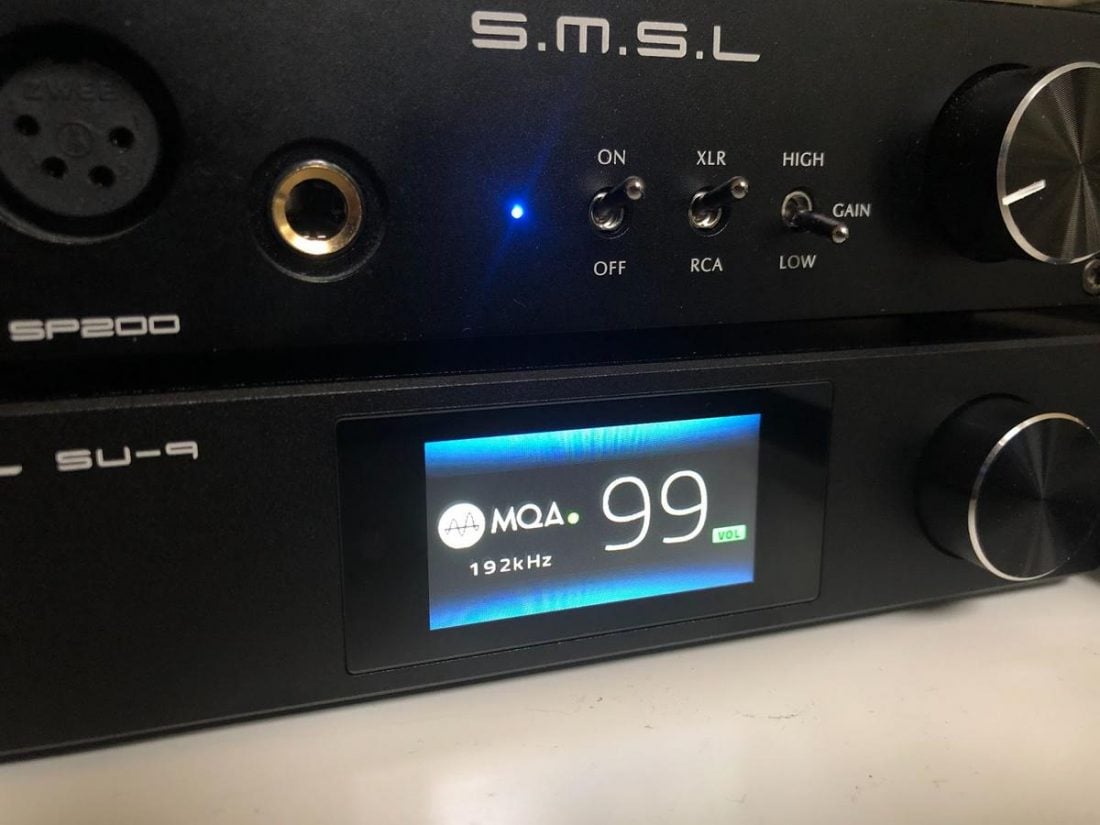
As you may imagine from the combo of SMSL’s pedigree and a TOTL ESS chipset, the SU-9 is designed to dominate the measurement-based DAC category. Its technical prowess is undeniable. The feature set is incredibly robust. Adding to the SU-9’s resume is an interface full of user-selectable sound and filter modes. In short, the SU-9 is a music-loving tweaker’s dream!
I guess we’d better give it a listen to see if it delivers on all that promise.
Company Overview
SMSL stands for the Foshan ShuangMuSanLin Technology Co., Ltd. Founded in 2009, SMSL is located in Shenzhen, China. They have their own R & D, manufacturing, and marketing teams and specialize in producing audio products, including DACs, stereo headphone amplifiers, speakers, and power amplifiers.
SMSL has established a comprehensive sales network, and its products are exported to more than 30 countries worldwide. SMSL states that they are “quality-based, technology-guidance, customer central.” They strictly execute the Electronics Industry rules (EICC) and have passed the CCC, BQB, MFi, CE, FCC, RoHS, CE-EMC, CE-LVD, WEEE certifications.
Technical Specifications
- Form: DAC
- Digital inputs: USB/Optical/Coaxial/Bluetooth
- Analog outputs: RCA/XLR
- THD+N: 0.00009%(-121dB)
- Dynamic range: XLR 130dB, RCA 123dB
- SNR:130dB
- Output impedance: XLR 207Ohms, RCA 142Ohms
- Bit depth: USB 1bit,16-32bit, Optical/Coaxial 1bit,16-24bit
- USB sampling rate: USB PCM 44.1-768kHz, DSD 2.8224-22.5792MHZ,
- Optical/Coaxial sampling rate: PCM 44.1-192kHZ, DSD dsd64(DoP)
- Bluetooth sampling rate: UAT: 24bit/192kHz (1200kbps/900kbps/600kbps), LDAC: 24bit/96kHz (990kbps/660kbps/330kbps), aptX-HD: 24bit/48 kHz-576kbps, aptX: 16bit/44.1 kHz-352kbps, SBC: 16bit/44.1 kHz-328kbps, AAC: 16bit/44.1 kHz-320kbps
- Power Consumption: 5W, <0.5W (standby)
- Size: 187.5X154X40mm (WxHxD)
- Weight: 800grams
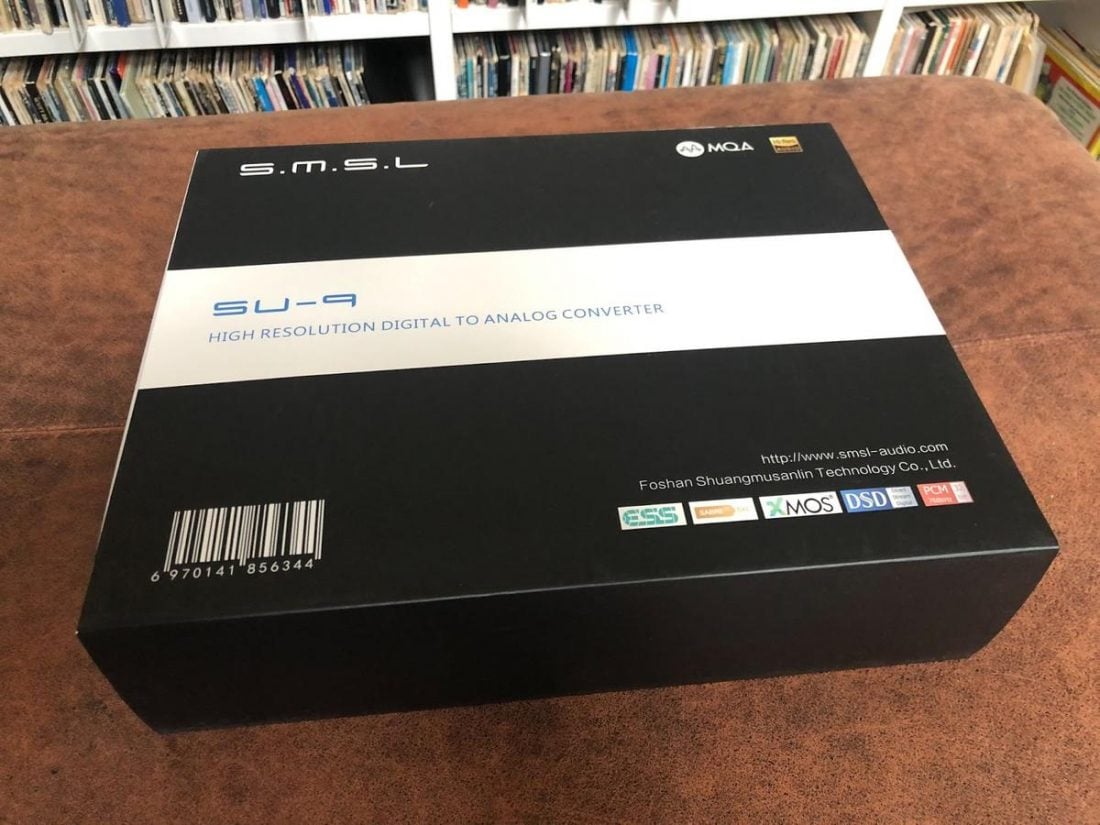
Packaging
SMSL doesn’t waste any time trying to sell you with the box. For such a feature-rich and complex device, the outer black cardboard sleeve is surprisingly devoid of technical data or specifications. Instead, it’s a clean design with the brand and model prominently displayed and a host of logos (MQA, ESS, Hi-Res Audio, etc.) along the top and bottom.
Inside is a plain white box with a foam insert protecting the device. Accessories are pretty minimal as well, with only the bare necessities included in the package.
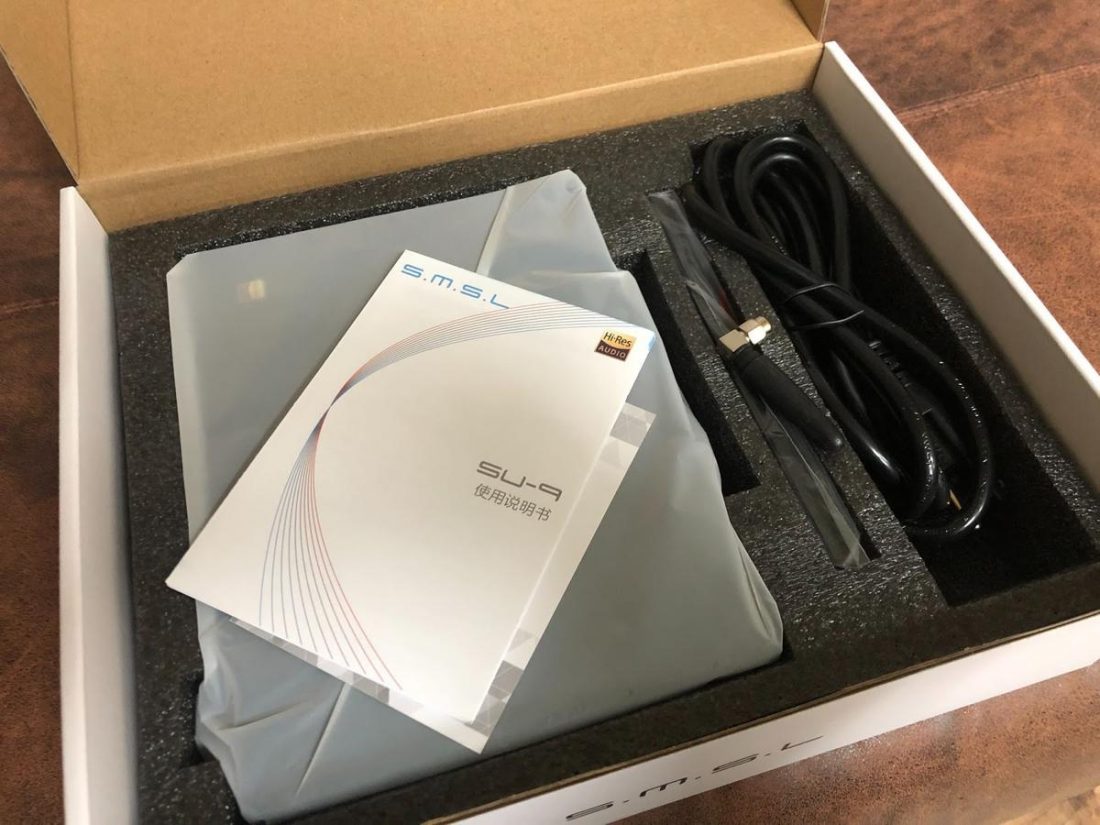
In the box
- SMSL SU-9 DAC
- Power cord (1m – grounded 3-pin)
- Remote control (same design shared between models)
- Bluetooth antenna
- USB-A to USB-B cable
- Manual
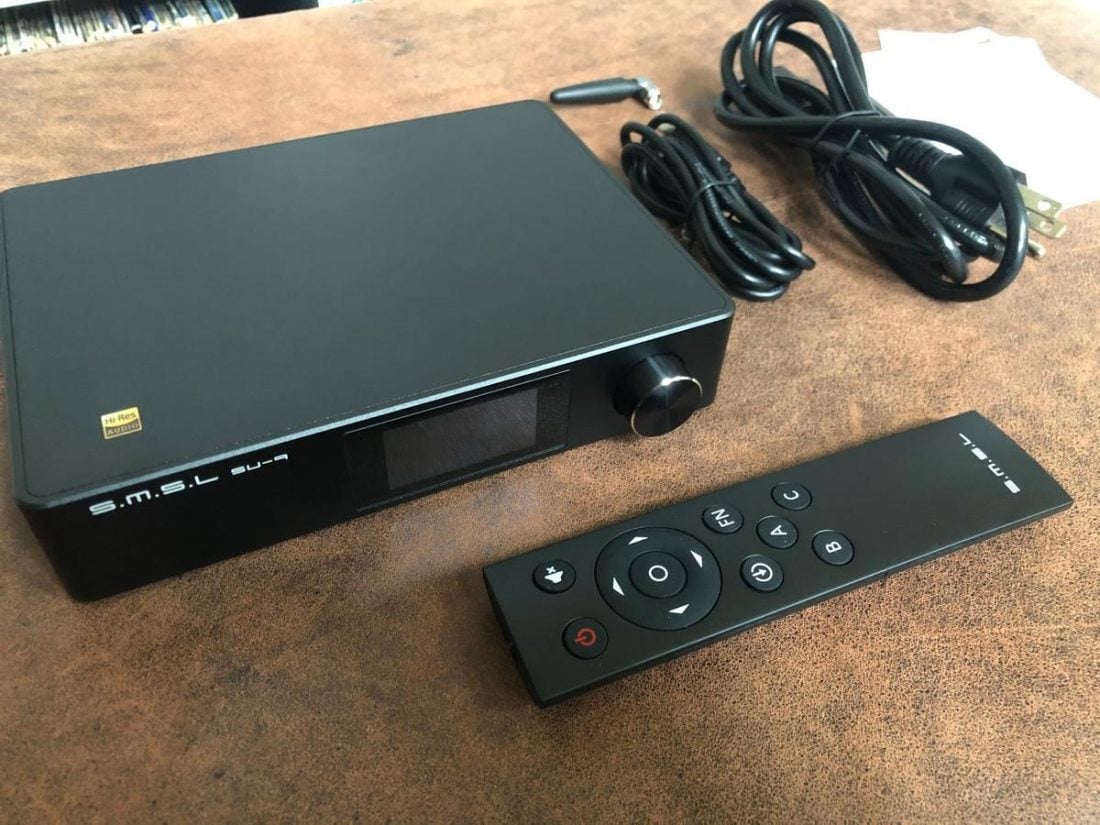
Design
The SU-9 features SMSL’s most recent design and form factor. It’s constructed of a single piece of CNC milled aluminum for the front, back, and sides, with separate top and bottom plates screwed on. It’s well made and feels robust and clean. The front panel is only interrupted by a bright 1.9” full-color TFT LCD color screen and a single multi-function knob.
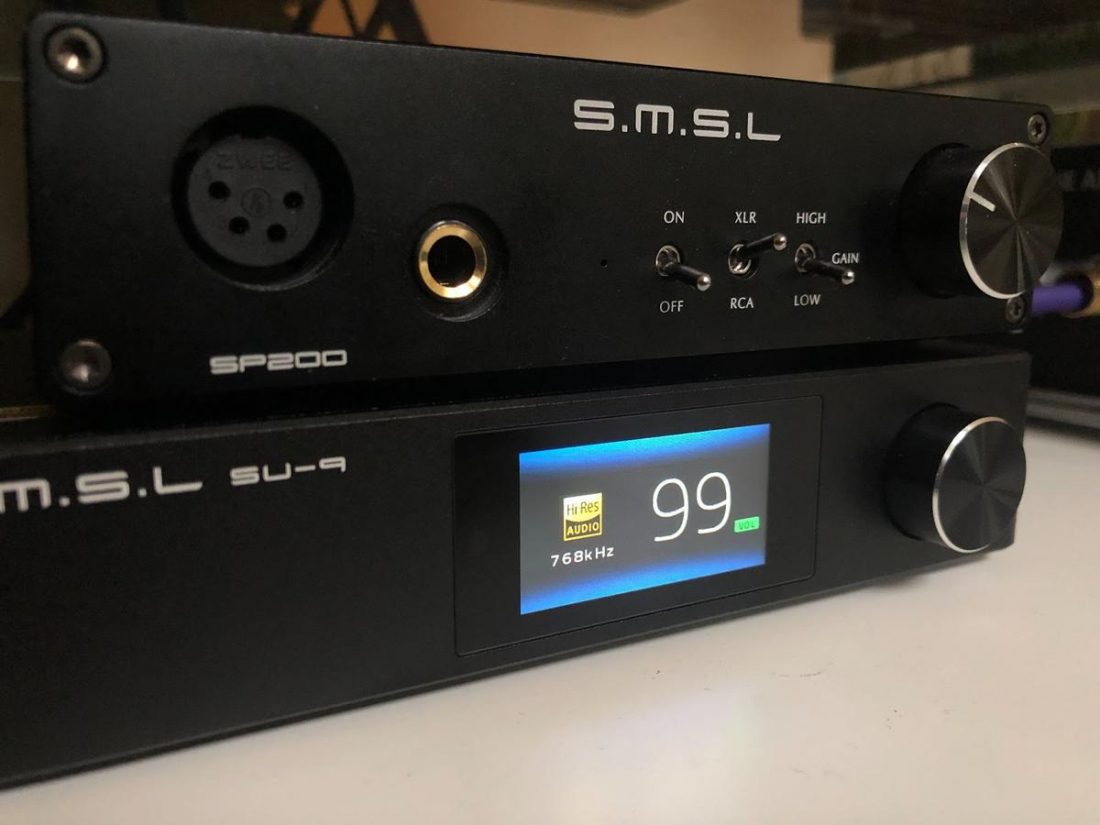
The aluminum knob is a push-to-select rotary controller which allows the user to power the device on and off, control the volume, and enter and select from the menu options. The knob is also a perfect match for the SMSL SP200 amplifier, has a notched feel when turned, and works well.
On the bottom of the SU-9 is a multi-pin port with an unknown purpose. Does it simplify in-factory re-programming? Will it add support for device connections (like an amplifier or streamer) in the future without external cables? It’s very mysterious!
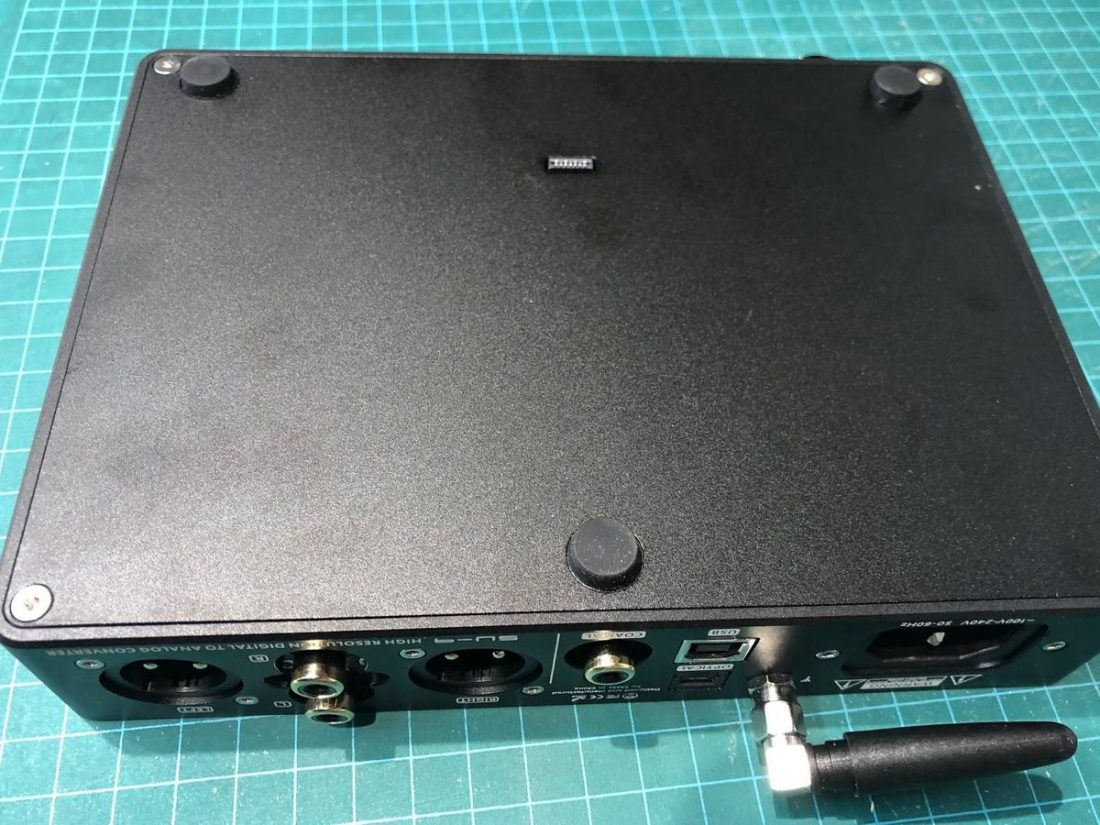
The rear panel is fully kitted out with a 3-pin IEC power socket (for the internal power supply), digital inputs (USB, optical, and coaxial), analog outputs (RCA and XLR), and a Bluetooth antenna. The analog outputs are concurrently active and can be toggled in the menu between fixed line-level or volume-controlled for use as a pre-amplifier.
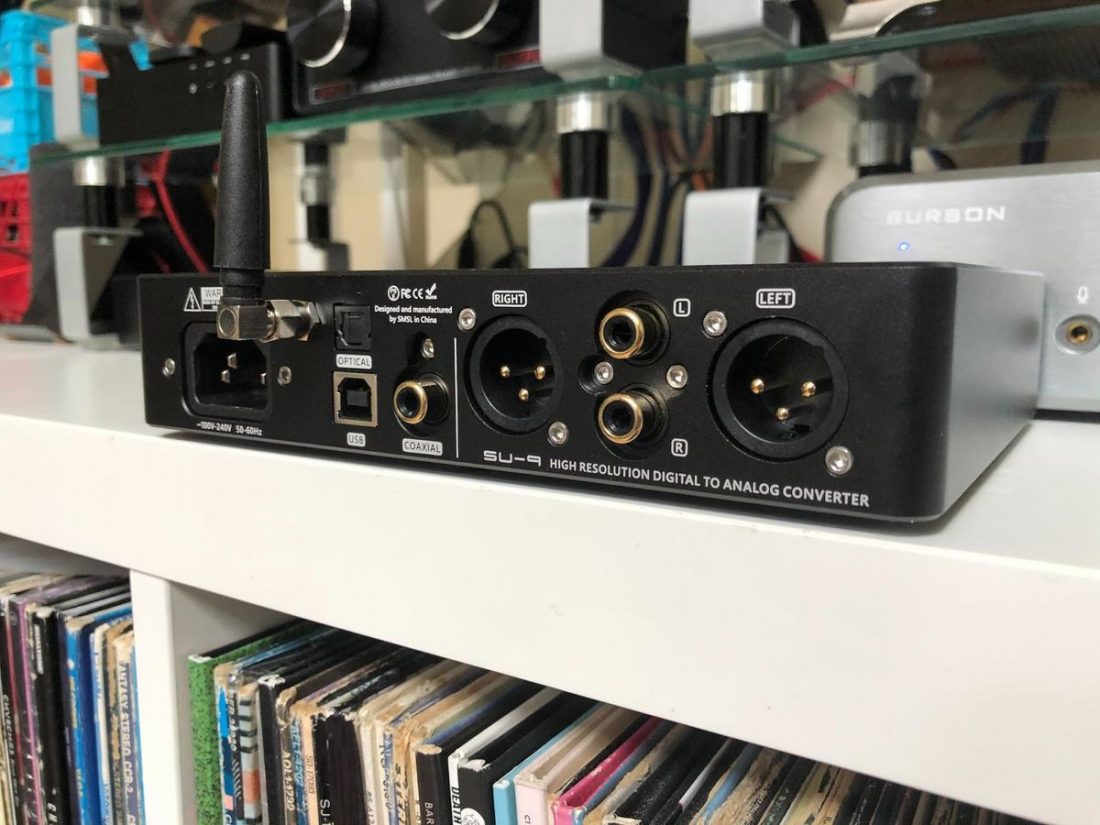
Interface
The combination of a clear, bright screen and a tactile knob makes for a good user experience. Long press to power toggle the SU-9, short press to enter the menu system, and rotate for volume control and navigation. It’s intuitive. My only trivial concern is that the main menu does not have an ‘exit’ option to go back to the main screen, and it is necessary to wait 10-15 (long) seconds for it to time out.
The remote is simple and functional as well, although because it is a shared remote between SMSL devices and can control three components, you must press the ‘C’ button before it functions with the SU-9. As one who eschews reading the manual upon the initial setup, I was quite convinced that the remote was DOA after swapping a few pairs of batteries. Once I stumbled across the ‘C’ button necessity, all was well.
Menu
The plethora of options found within the sub-menus led me to a bit of self-discovery. Some folks don’t want to be shackled by the manufacturer’s decisions and compromises. They want to change and tweak every function, reveling in the control and the minutiae. The SU-9 is the perfect DAC for this consumer.
Other folks (and it turns out that I’m one of them), prefer a DAC to automatically be set to the “BEST SOUND” option and don’t want to spend their valuable listening time figuring out which of the last eight options sounded better than the current one. A power button, input selector, and volume control may be enough.
Lest you think I’m exaggerating the sheer number of menu options, the SU-9 allows users to toggle between seven PCM filters, four DSD filter cutoffs, ten sound colors, fifteen DPLL bandwidth settings, and the list goes on. Multiply that all together to see how many unique combinations you can come up with.
The SU-9 sneers with contempt at the KISS (keep it simple stupid) philosophy.
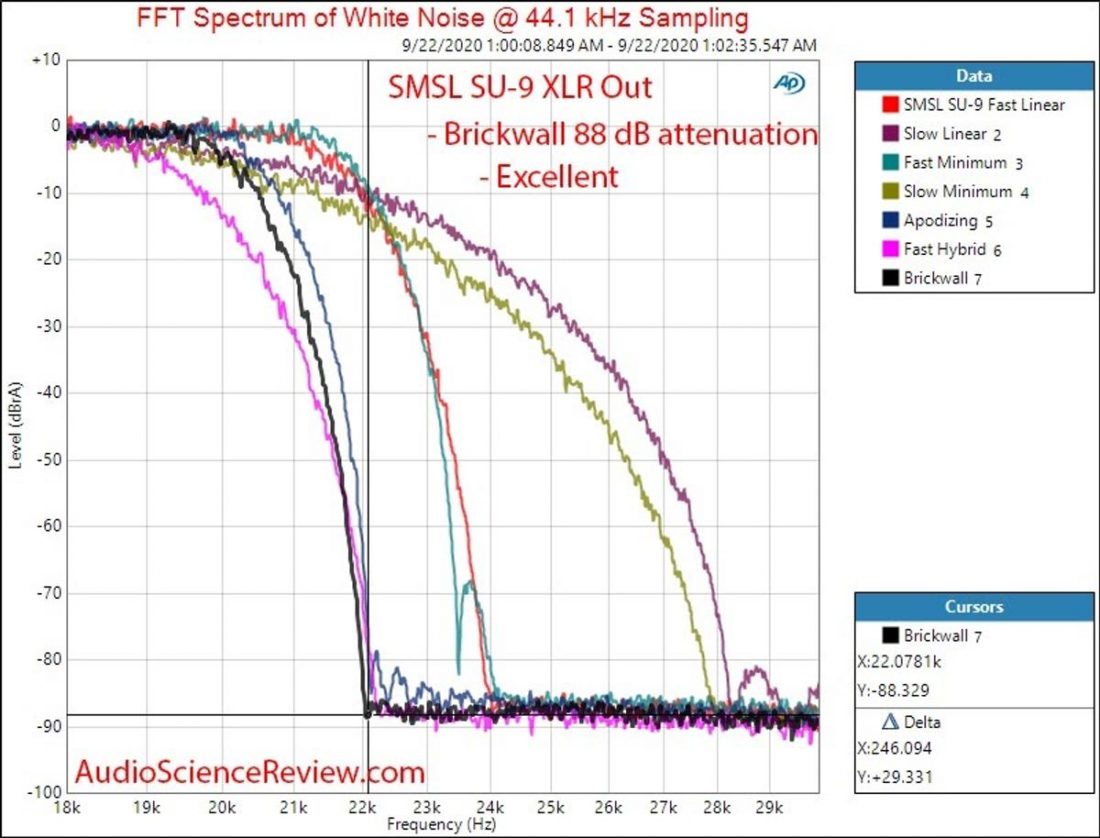
Menu options
- INPUT – Change between USB, Optical, Coaxial, and Bluetooth digital inputs.
- PCM FILTER – These are the standard filters for current ESS DAC chipsets. In my experience, they make minimal sound changes. You can play around with them, but I tend to leave it at the default apodizing fast roll-off filter or brick wall filter.
- Linear phase fast roll-off filter
- Linear phase slow roll-off filter
- Minimum phase fast roll-off filter
- Minimum phase slow roll-off filter
- Apodizing fast roll-off filter
- Hybrid fast roll-off filter
- Brick wall filter
- DSD FILTER – 47, 50, 60, or 70 kHz – Alters the cut-off frequency of the DSD stream. I stick with the default.
- SOUND COLOR – Changes distortion levels to tailor the sound. A more noticeable impact on the timbre and overall sound than the PCM Filter options, but is subtler than most EQ presets. Levels 1-3 affect the intensity of the effect. Rich and Tube tend towards warmth while Crystal is brighter.
- Standard
- Rich 1,2,3,
- Tube 1,2,3
- Crystal 1,2,3
- PRE MODE – Set to ‘Vol Fixed’ if using as a DAC for an amplifier, or ‘Vol Variable’ if wanting volume-controlled preamplifier functionality.
- DPLL – 1, 2, 3, 4, 5, 6, 7 (default), 8, 9, 10, 11, 12, 13, 14, 15 – bandwidth adjustment that affects jitter attenuation, and is most likely only useful if using the optical input.
- BRIGHTNESS – 1, 2, 3, 4, 5, 6 – Changes the screen brightness (1 lowest, 6 highest).
- RESET – Resets the unit back to default values.
- VERSION – Displays the current software, hardware, and USB versions.
Internals
As I’m sure you’ve picked up, the SU-9 is a technological marvel. It boasts the flagship, 8-channel, ES9038Pro chip, and associated ES9311 voltage regulators. The output stage is based on Texas Instruments Burr-Brown OPA1612 dual op-amps (one for single-ended RCA and two for balanced XLR).
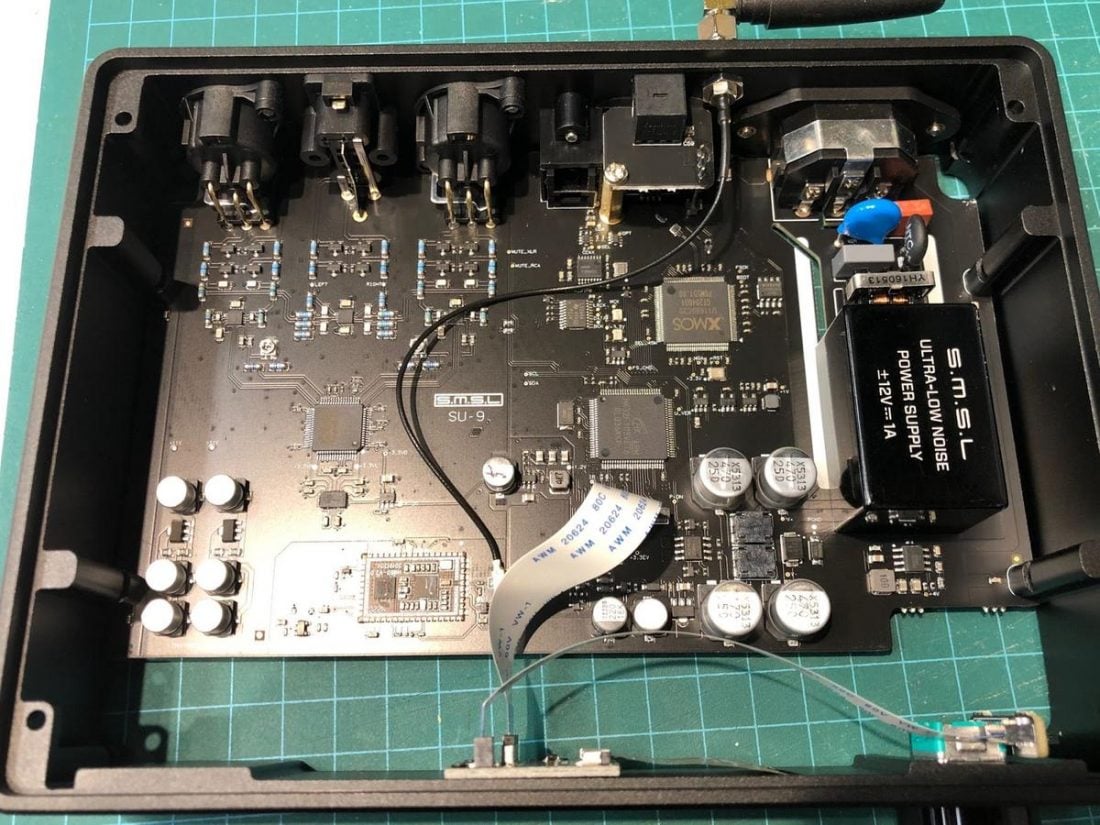
All that processing power means the SU-9 natively and fully decodes MQA, supports 32-bit/768kHz PCM, and DSD512.
Like the SMSL SP200 amplifier, the internal ultra-low noise power supply is located within the case, rather than utilizing a wall-wart type power adapter.
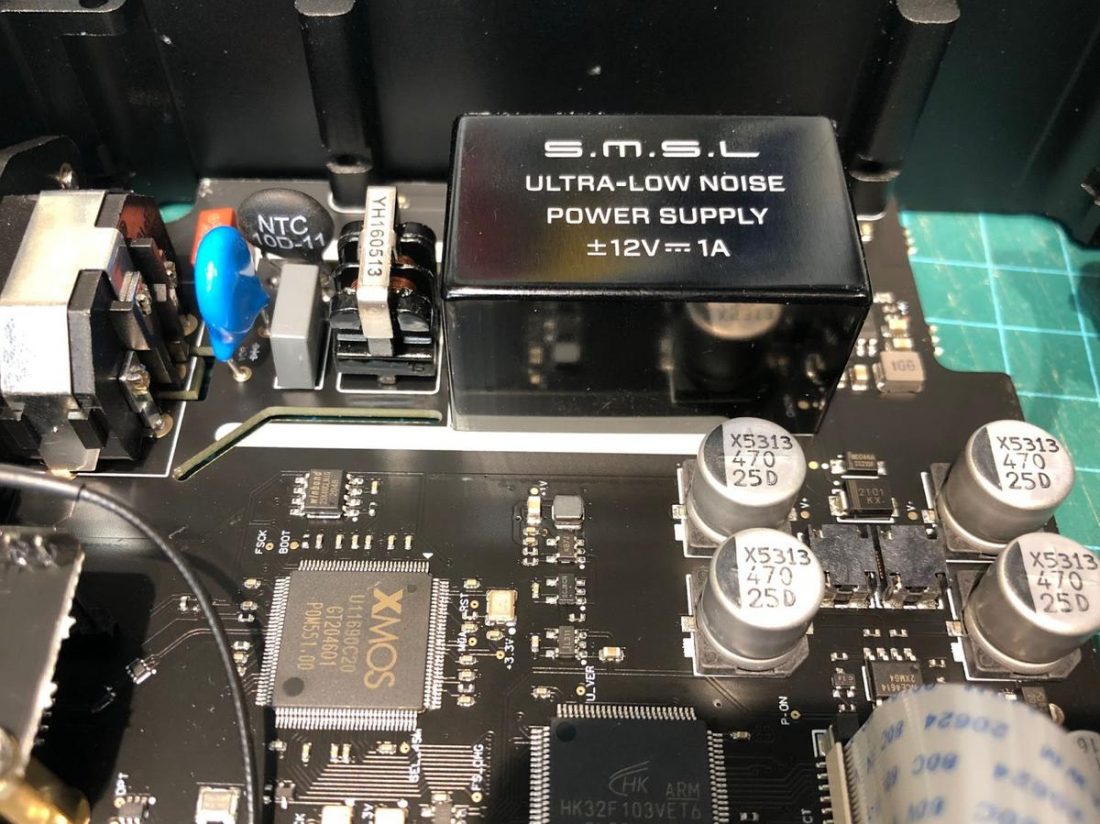
Bluetooth
The SU-9 supports all the standard Bluetooth codecs, including AAC, SBC, aptX, aptX-HD, and LDAC. Of note, it also supports the new Ultra Audio Transmission (UAT) codec designed by the HiBy company. UAT uses HiBy’s proprietary algorithms to work around data transfer limitations to support higher resolution audio. Initially only available on HiBy DAP products, UAT appears on other devices like the Hidizs AP80 Pro and Cayin N8.
| Bluetooth Codec | Bit Depth (bit) / Sample Rate (kHz) | Supported Bit Rate (kbps) |
|---|---|---|
| UAT | 24/192 | 1200/900/600 |
| LDAC | 24/96 | 990/660/330 |
| aptX-HD | 24/48 | 576 |
| aptX | 16/44.1 | 352 |
| SBC | 16/44.1 | 328 |
| AAC | 16/44.1 | 320 |
With the external antenna attached, the Bluetooth range is impressive and more than capable of uninterrupted playback from my phone, even at the extremes of my smallish house. Using the UAT connection from my Hidizs AP80 Pro, audio quality is excellent and virtually indistinguishable from a wired connection. Bluetooth audio has come such a long way in the last few years.
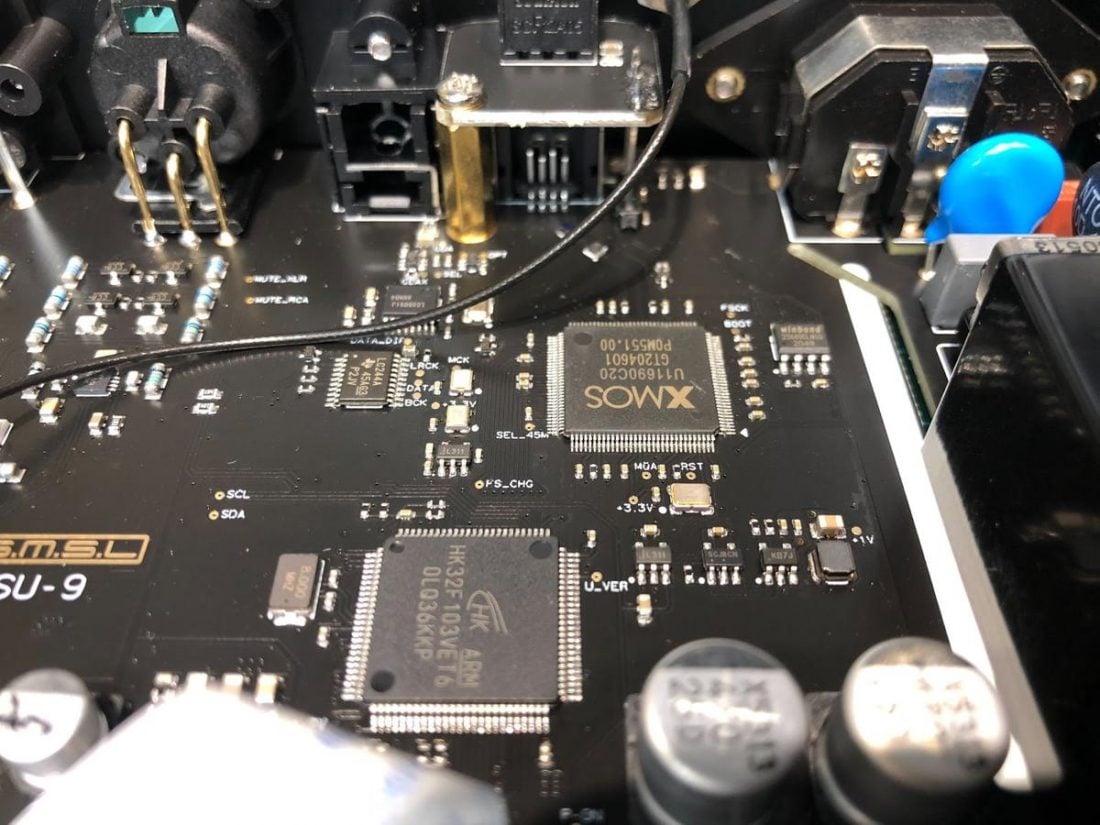
SMSL SU-9 Sound
As the SU-9 has a plethora of sound-shaping options, the notes below reflect listening with the default settings to remain consistent. I paired the SU-9 with several amplifiers, including the SMSL SP200 (THX amplifier), Bottlehead Crack (OTL tube amplifier), and Hagerman Tuba (single-ended, zero-feedback, parafeed EL84 triode amplifier). Headphones varied primarily between the Sennheiser HD650, Audeze LCD-2, HEDDphone, and Ultrasone Edition 15 Veritas (amongst a few others).
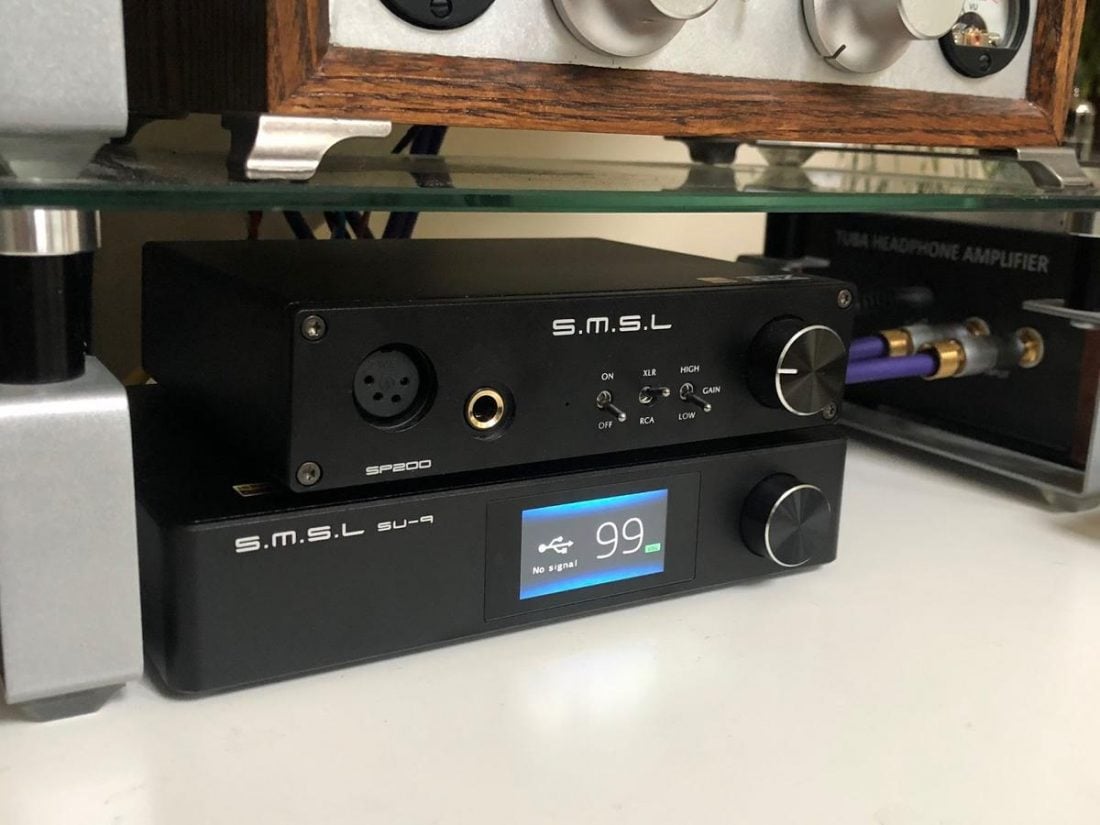
Frankly, amplifier and headphone choice have a more significant impact on the sound signature than does the DAC. There. I said it, and I stand by it. In my world, high-quality DACs should perfectly deliver the music with a minimum of coloration and imparted personality. They should provide a flawless foundation that the listener can build their own sound signature preferences upon.
That isn’t to say that DACs should sound sterile, lifeless, or dull. And those are criticisms sometimes directed at ESS Sabre chipset-based DACs. One way that the SU-9 avoids this trap is to provide so many ways to tailor the sound. Want it to sound different with your gear? Head on in to the menus and start changing things.
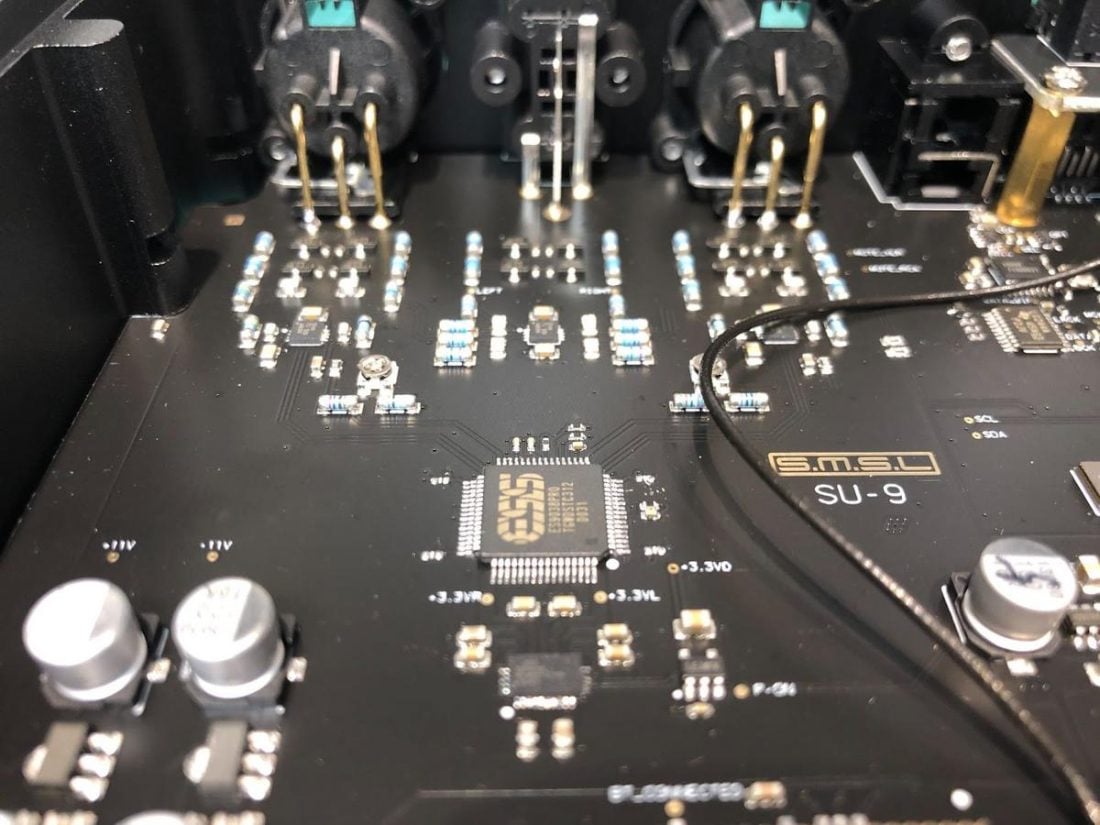
But as they say, a DAC is more than simply a chip, and the entire circuit design and componentry all play a role in the overall sound. In this case, the SU-9 leans a hair more towards the full, warm, midrange-focused side of things, at least as far as ESS DACs go. It’s still remarkably detailed and resolving, and manages to avoid undue glare and grain.
Indeed, the choice of attached amplifier dramatically determines what the end product sounds like. Paired with an ultra-clean THX amplifier like the SP200, the sound is far more analytical and transparent than with tubes in the chain. The technically capable SU-9 makes an excellent base for almost any system and is flexible enough to fulfill most conceivable tastes.
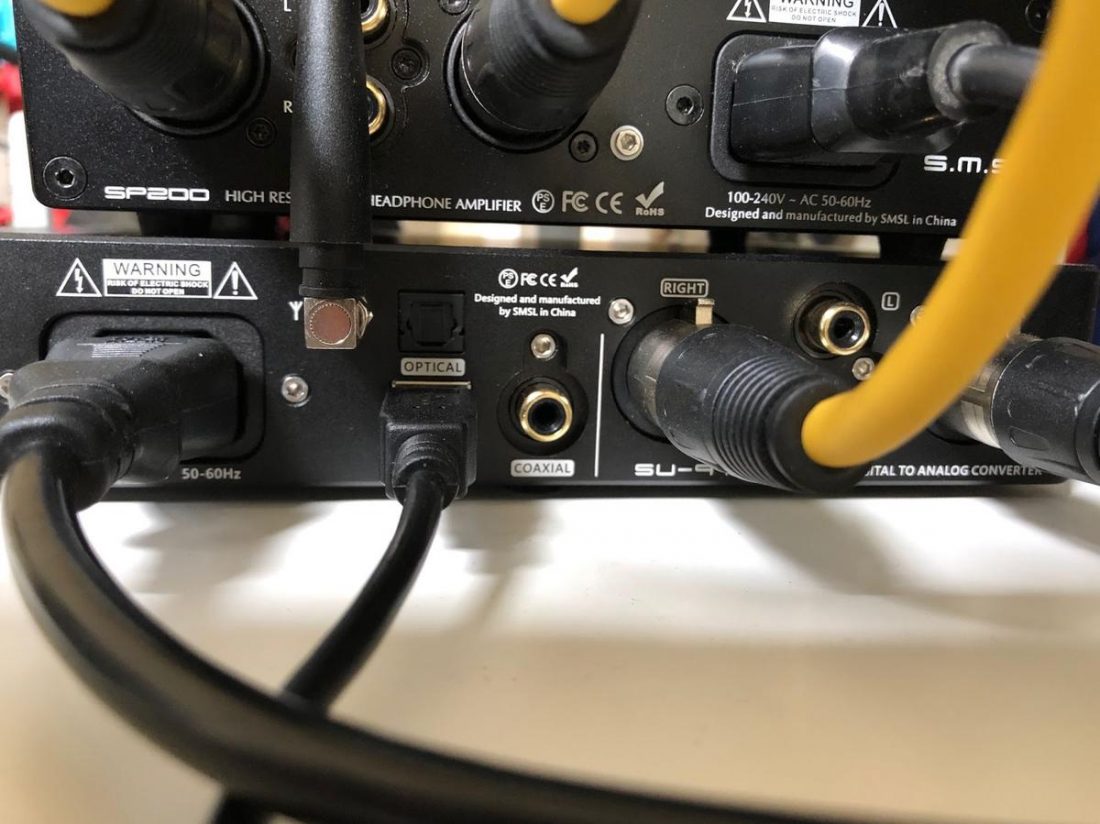
The measurement-minded folks over at AudioScienceReview.com had many positive things to say regarding the SU-9. Several Chinese designed and manufactured DAC companies (such as Topping, Soncoz, Khadas, and SMSL) seem to be in a perpetual arms race for measurement perfection, and the SU-9 is the latest contender.
“Wow! Another DAC nearly maxing out the distortion+noise meter in my analyzer! The SINAD of 120 dB puts the SU-9 way up there in rankings… Our old friend the “ESS IMD Hump” is still there but 90% suppressed… Linearity which is a measure of accuracy is perfect… Jitter over USB is non-existent.
…a trend to achieve perfection in desktop DACs and the SMSL SU-9 is yet another example of that. We have another great “instrument grade” DAC on our hands providing absolute transparency to the source beyond any threshold of human hearing.” – AudioScienceReview
The SU-9 sounds linear, virtually uncolored, and transparent. It’s not so analytical as that it overshadows the music. Instruments and vocals remain natural and real sounding. The SU-9 is just smooth enough to balance all the details.
Is it hugely different from listening to the great Soncoz LA-QXD1 DAC or another top-tier measuring 9038-based DAC? Of course not. The SU-9 simply shares too much of the same pedigree to be anything but reasonably similar.
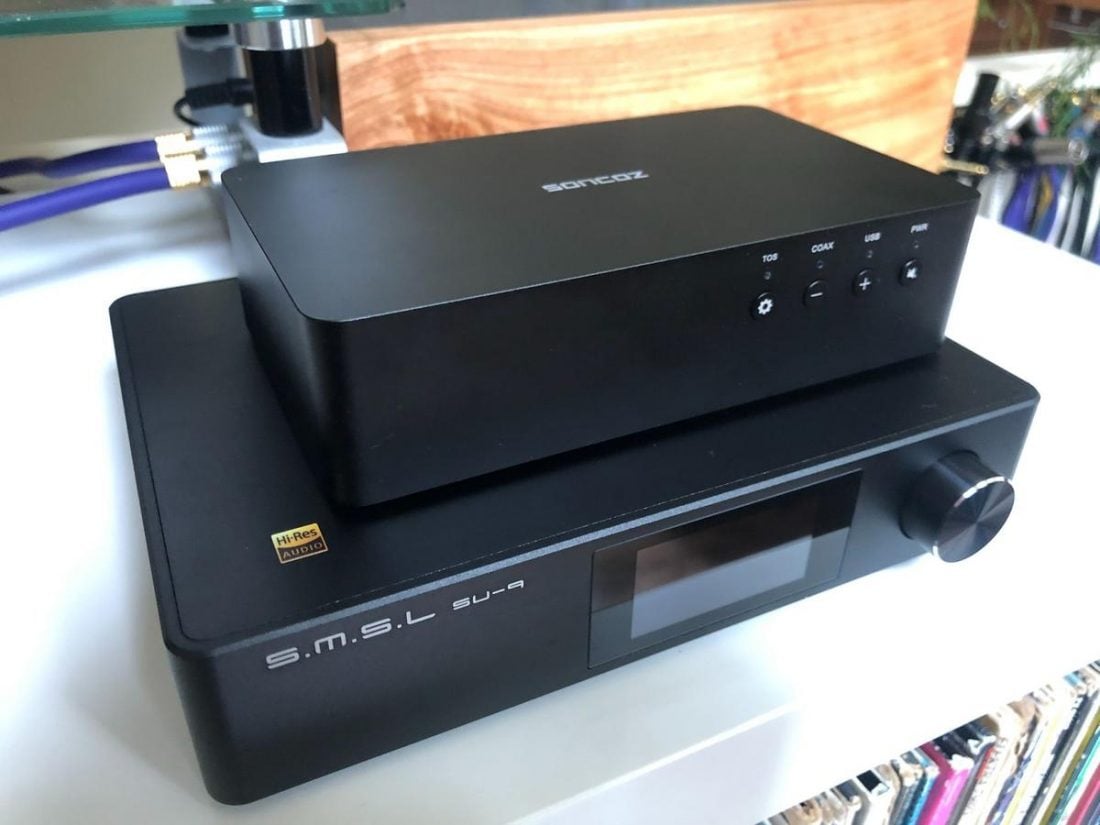
The SU-9 does, however, have tons of features and a great screen to differentiate it from comparable (and competing) models. It also has a little audible edge in how it rounds off the sharp corners and presents a smooth, enjoyable sound.
Where to Buy
Conclusion
What makes a DAC futureproof? Include every conceivable input and output option: check. Include Bluetooth support for all codecs, including new up-and-comers: check. Support the highest resolutions and formats: check. Let the user change every conceivable setting: check.
Based on that checklist, the SMSL SU-9 is the very definition of futureproof.
It’s good to be attractively and robustly made and feature some perks like a legible screen and remote control. A reasonable price tag also helps.
Oh yeah, it must sound good as well.
There’s no question that the SU-9 more than fulfills the DAC needs for a great number of systems and audiophiles. If you are in the market for an ESS-based DAC, and your budget allows, there are very few reasons you should be considering anything else than the SU-9.
The SU-9 shows that the Chinese-made, perfect-measuring DAC race is starting to mature. While lower-priced models may share some of the same features, the SU-9 ups the ante with more focus on the sound. The ability to tailor the ‘sound color’ distortion levels and an overall smoother presence distinguish the SU-9 from lesser models.
Frankly, unless you are only interested in esoteric and uber-expensive DAC options, I’m not sure who wouldn’t be happy with the SU-9 anchoring their system.

Trav, you hit the nail on the head. The SMSL SU-9 is the DAC for Everyman. It’s priced affordably, it’s packed with features, it’s future proof (well, as much as any DAC can be), it’s MQA full decoding is nigh on perfect, and it’s sounds great. What more can one ask?
How well did the SP200 work out with this
They work fine together. Both are very clean and clinical, so if that’s the sound you are after, it’s a good pairing.
Would you say this is less harsh or warmer? sound. I think I would like a warmer sound. I’m looking at this DAC the SU-9 and the SU-8S, DO200, LOXJIE D50, LOXJIE D40, M500 MK2, and the VMV D1SE or the SU-9N. I stream music with Tidal and never heard MQA but would like to have.
I would describe the SU-9 as clean and clear. It’s neither harsh, nor warm. But we’re splitting hairs. If you want a warmer sound, the headphones (and to a lesser extent amplifier) are going to make a far larger impact on the quality of sound you hear.
Would the SMSL SP200 work or would the SINGXER SA-1 amp to match the D1SE. And would the D1SE be better than the SMSL M400
I would agree with Trav. You’re choice of headphones will be the deciding factor in how you perceive the sound. A warm, darker headphone (such as Audeze) will give you what you want. I personally would rather have my DAC as neutral as possible and “flavor” my sound with my choice of headphones.
I have the HifiMan Ananda for headphones with the SMSL SP200 Amp
@john which Audeze would you think to go with the Ananda or sound warmer less harsh. I have treble issues that mess with my head nerves
I can’t speak for the entire line, as I’ve not heard them. But I bought the LCD-2C’s because they aren’t piercing on top. More dark and lush.
Great review. I bought the sd9 and matched it up with this su9. I have them playing through my vintage mcintosh ma6100 integrated amp. What a sound. By the way, I’ve owned my Mac since 1976. Daily operation and it’s never been serviced.
I’m a vintage Marantz guy myself, but McIntosh is wonderful gear!
Hello Trav,
Recognizing it’s been awhile since you reviewed the SU-9, I will take a shot in seeking some help.
I’m far from an audiophile, but I have tried to find the best sound at the best price in my 62 years. That said, I did incorporate this DAC into my system a couple of years ago and as a replacement for an Emotiva DAC that had died, I was pleasantly surprised. I have vintage speakers that like a lot of juice, and along with this DAC, the speakers began to speak a whole new language.
So fast forward to today, and I find myself unable to solve a distortion issue. Two of my speakers (each of which have 4 woofers, 4 tweeters/ Epicure 400’s) have been producing such a distorted sound that I actually pulled one of the woofers and sent it to Huw at Human Speakers to see if perhaps a voice coil had been damaged. He reported that is not the case. (I’d replaced the original woofers with Huw’s with great results)
Mind you, the primary source for my listening in recent years as been my phone via bluetooth. And, yesterday, I chose use my CD player as the source, and low and behold, I had no distortion….
That fact alone was a relief as the level of distortion was so bad I thought the woofers might actually suffer permanent damage.
So now I’m scratching my head trying to figure out if the DAC’s processing of the bluetooth signal may be the culprit? In looking at the DAC again for the first time in ages (outside of turning it on and off, I have not touched it ) I realized there are some (way too many for me) filter/other settings, I’m wondering if there is a setting I might adjust to resolve this issue.
I’ll be using USB Hifi later today from my computer and also try connecting my Ipod which longs to get in the game via a Wadia dock…
I’m glad the speakers are ok, but having difficulty narrowing this down. My system is a 7.2 set up which is used only for music..ie, not for home theater. 7 Epicure speakers of varying models, and 2 M & K powered subs. 3 B & K amps @ 250 wpc.
If you have any suggestions, I’m all ears. Thanks in advance for any time your put into a reply. All the best,
Christopher
Hi. I’m still using the SU-9 as the DAC for my ‘The Fisher’ vintage receiver. I don’t think there is a setting that would cause distortion issues. My best suggestion is to try narrowing down the culprit. Try a different bluetooth source. Delete the SU-9 in your phone and re-add it fresh. Did you try the CD player digitally connected to the SU-9 (to try it not via Bluetooth)? Definitely also try the USB connection. Hopefully all this will let you determine the faulty component in the chain.
Good luck!